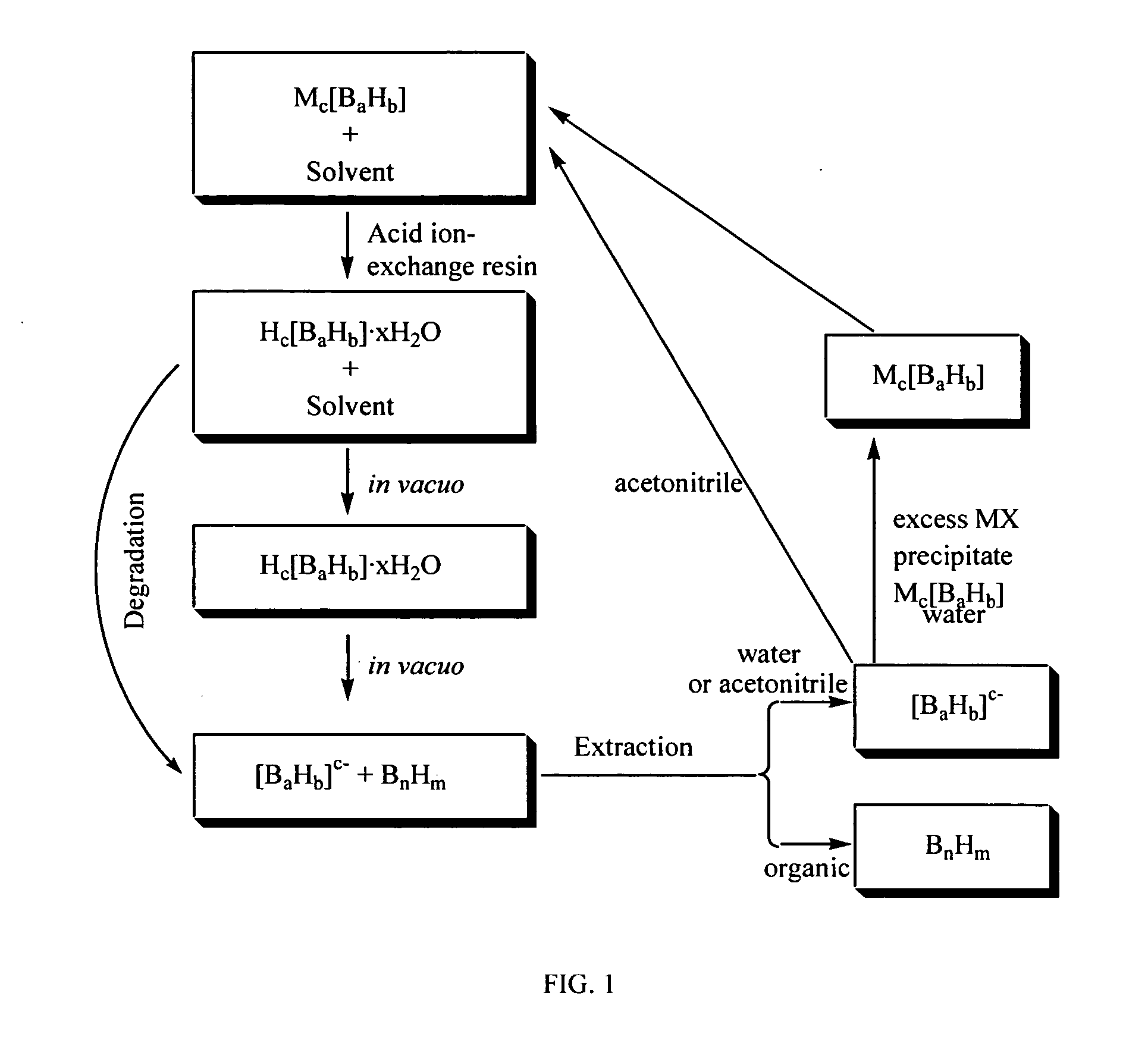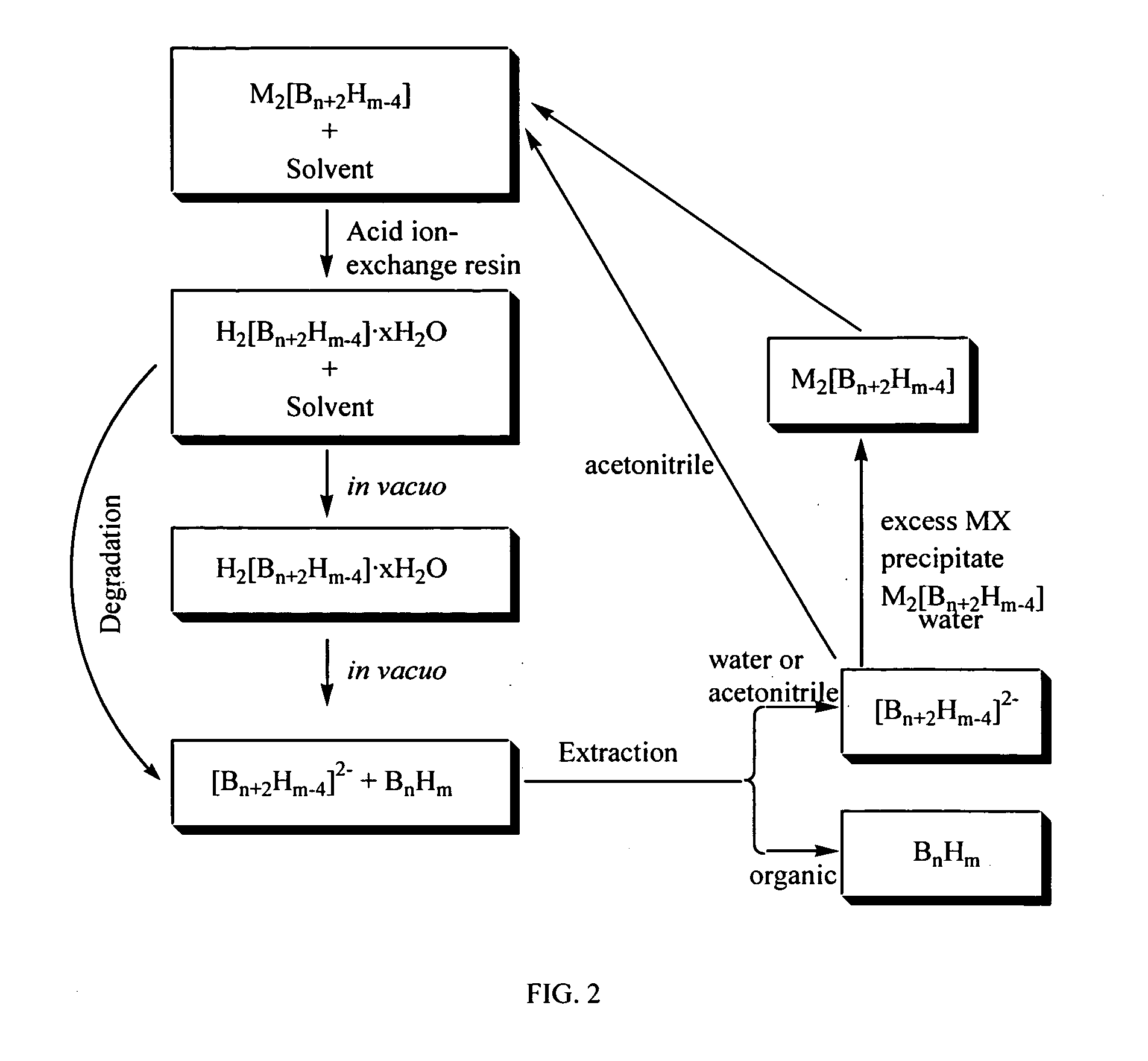Isotopically-enriched boranes and methods of preparing them
a technology which is applied in the field of isotopically enriched boranes and methods of preparing them, can solve the problems of complicated synthetic processes, hampered methods of manufacturing boron doped p-type junctions, and inability to meet the requirements of boron hydride p-type junctions, etc., and achieves the effect of high overall synthetic yield
- Summary
- Abstract
- Description
- Claims
- Application Information
AI Technical Summary
Benefits of technology
Problems solved by technology
Method used
Image
Examples
example 1
[0116] A solution of (Et3NH)2[B20H18] (33 g, 75.3 mmol) in 1500 mL of absolute ethanol:acetonitrile (90:10 by volume) was prepared and then passed through a 500 g acid ion-exchange column as described in Olsen (J. Am. Chem. Soc., v. 90, 3946-3952 (1968)). Following the procedure provided by Olsen, 2.07 g (9.58 mmol) of B18H22 was obtained from the cyclohexane portion of the cyclohexane-water extraction of the viscous yellow oil. The aqueous solution and residue was treated with an excess of triethylammonium chloride which induced copious precipitation of reclaimed (Et3NH)2[B20H18] (26.5 g, 60.5 mmol). Thus, after the first passage through the acid ion-exchange gave a 12.7% yield of the desired B18H22 boron hydride compound and an 80.3% recovery of the starting (Et3NH)2[B20H18] salt (corresponding to a 7.6% loss of starting material). Redissolution of the recovered (Et3NH)2[B20H18] in absolute ethanol:acetonitrile (90:10 by volume) mixture and passage through the regenerated acid ion...
example 2
[0118] A solution of (Et3NH)2B20H18 (52.7 g, 120.1 mmol) in 320 mL of a 15:1 acetonitrile:water mixture was stirred with 300 g of acid exchange resin for 1 hour. The resin was filtered away from the yellow filtrate and rinsed with acetonitrile until the washings ran clear. The solution was concentrated on a rotary evaporator to ˜300 mL and placed on a column containing 300 g of acid exchange resin. The solution was eluted with acetonitrile and volatiles removed until a viscous yellow oil resulted. However, the viscous yellow oil was continually exposed to vacuum until a yellow, soft, sticky solid was formed (about 48 hours). 4.6 g (21.2 mmol) of B18H22 was obtained from the cyclohexane portion of the cyclohexane-water extraction of the sticky yellow solid. The remaining B20H182− was recycled by the addition of NEt3 as in Example 1. The recovered B20H182− was dissolved in 320 mL of a 15:1 acetonitrile:water and stirred over acidic exchange resin for 20 hours. The resin was filtered a...
example 3
[0119] 25 mL of water was added to a solution of (Et3NH)2B20H18 (282.3 g, 643.4 mmol) in 500 mL acetonitrile. The solution was placed onto a column containing 2 kg of acidic exchange resin and allowed to sit for 18 hours. The yellow solution was eluted with acetonitrile until the eluant ran clear. The collected acetonitrile solution was concentrated to ˜500 mL and placed onto a second column with 2 kg of acidic exchange resin. The solution was eluted slowly over 2 hours and the column rinsed with acetonitrile and the washings ran clear. Acetonitrile was removed until a viscous yellow oil resulted. The oil was subjected to high vacuum until hydrogen evolution began and a hard solid formed (˜10 days). The hard yellow solid was extracted using a mixture of 750 mL of cyclohexane and 750 mL of water. The cyclohexane layer was separated from the water and cyclohexane removed to give pale yellow B18H22 (43.7 g, 201.6 mmol) in 31.3% one pass yield. The water layer was neutralized with triet...
PUM
 Login to View More
Login to View More Abstract
Description
Claims
Application Information
 Login to View More
Login to View More - R&D
- Intellectual Property
- Life Sciences
- Materials
- Tech Scout
- Unparalleled Data Quality
- Higher Quality Content
- 60% Fewer Hallucinations
Browse by: Latest US Patents, China's latest patents, Technical Efficacy Thesaurus, Application Domain, Technology Topic, Popular Technical Reports.
© 2025 PatSnap. All rights reserved.Legal|Privacy policy|Modern Slavery Act Transparency Statement|Sitemap|About US| Contact US: help@patsnap.com


